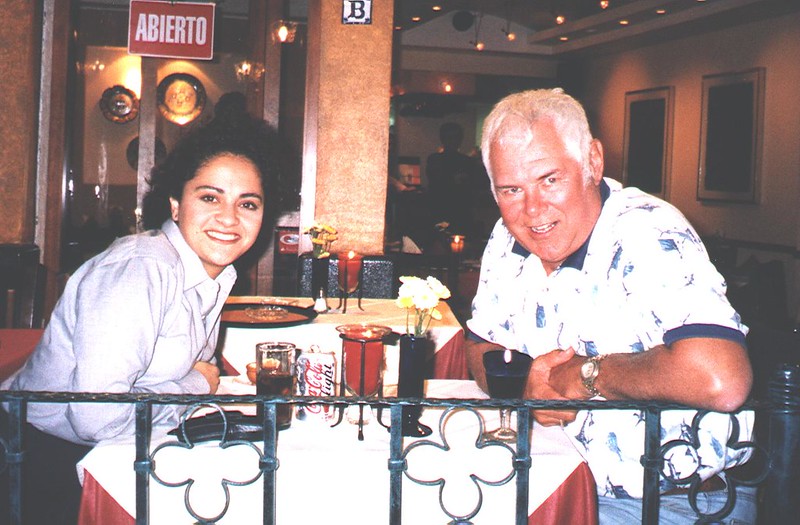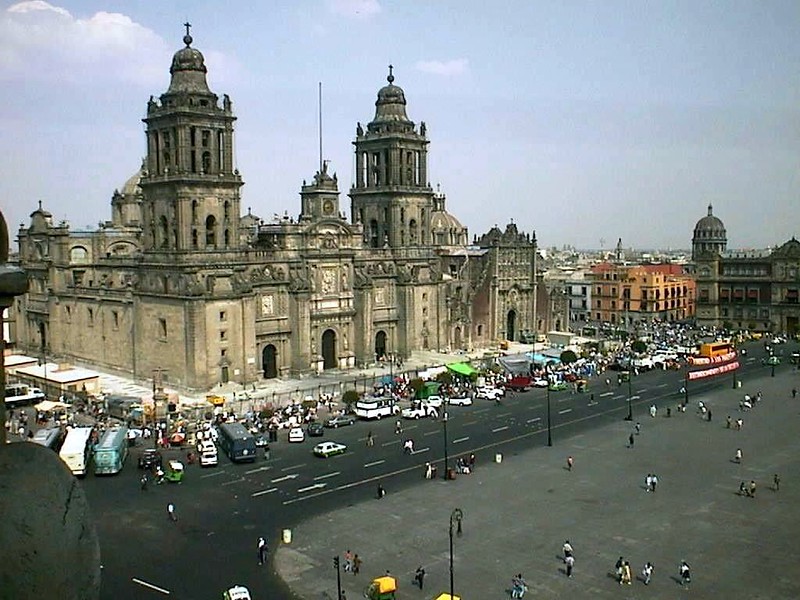Mexico city is not very pretty, danger & crime is everywhere. However there were so many things I didn’t know about this fascinating city till I met Malvina. She had studied history at university and explained so much about Mexico’s rich heritage. I am going to use a lot of information from Wikipedia in this post along with a couple of nice stories from my friend Malvina.
I don’t wish to offend people in Mexico when I refer to the crime & danger, my friend Malvina was held up & robbed 5 times in the previous 2 years. At ATMs & in her car while stopped at traffic lights, I rest my case.
Please forgive the poor quality of my photos, it was 1999 and my first digital camera left a lot to be desired.
My friend Malvina
We met online and became good friends when I called into Mexico City on my way to Rio Di Janeiro. Malvina was born in Lebanon and moved to Mexico with her family. A few years later she moved to Paris and we caught up with each other once again.
Pyramid of the Sun
I had absolutely no idea there were huge pyramids on the outskirts of Mexico City. Teotihuacan also written Teotihuacán, was a pre-Columbian Mesoamerican city located in the Basin of Mexico, 30 miles (48 km) northeast of modern-day Mexico City, which is today known as the site of many of the most architecturally significant Mesoamerican pyramids built in the pre-Columbian Americas. Apart from the pyramids, Teotihuacan is also anthropologically significant for its complex, multi-family residential compounds, the Avenue of the Dead, and the small portion of its vibrant murals that have been exceptionally well-preserved. Additionally, Teotihuacan exported a so-called “Thin Orange” pottery style and fine obsidian tools that garnered high prestige and widespread utilization throughout Mesoamerica.
The city is thought to have been established around 100 BC, with major monuments continuously under construction until about AD 250. The city may have lasted until sometime between the 7th and 8th centuries AD, but its major monuments were sacked and systematically burned around 550 AD. At its zenith, perhaps in the first half of the 1st millennium AD, Teotihuacan was the largest city in the pre-Columbian Americas, with a population of 125,000 or more, making it at minimum the sixth largest city in the world during its epoch. Platform along The Avenue of the Dead.
Mexico city is not very pretty but it certainly is fascinating.
 Scholars had thought that invaders attacked the city in the 7th or 8th century, sacking and burning it. More recent evidence, however, seems to indicate that the burning was limited to the structures and dwellings associated primarily with the ruling class. Some think this suggests that the burning was from an internal uprising. They say the invasion theory is flawed because early archaeological work on the city was focused exclusively on the palaces and temples, places used by the upper classes.
Scholars had thought that invaders attacked the city in the 7th or 8th century, sacking and burning it. More recent evidence, however, seems to indicate that the burning was limited to the structures and dwellings associated primarily with the ruling class. Some think this suggests that the burning was from an internal uprising. They say the invasion theory is flawed because early archaeological work on the city was focused exclusively on the palaces and temples, places used by the upper classes.
Because all of these sites showed burning, archaeologists concluded that the whole city was burned. Instead, it is now known that the destruction was cantered on major civic structures along the Avenue of the Dead. Some statues seem to have been destroyed in a methodical way, with their fragments dispersed. Evidence for population decline beginning around the 6th century lends some support to the internal unrest hypothesis.
The decline of Teotihuacan has been correlated to lengthy droughts related to the climate changes of 535-536 AD. This theory of ecological decline is supported by archaeological remains that show a rise in the percentage of juvenile skeletons with evidence of malnutrition during the 6th century. This finding does not conflict with either of the above theories, since both increased warfare and internal unrest can also be effects of a general period of drought and famine. Other nearby centers such as Cholula, Xochicalco, and Cacaxtla competed to fill the power void left by Teotihuacan’s decline. They may have aligned themselves against Teotihuacan to reduce its influence and power. The art and architecture at these sites emulates Teotihuacan forms, but also demonstrates an eclectic mix of motifs and iconography from other parts of Mesoamerica, particularly the Maya region.
Mexico City is absolutely fascinating & ancient.
 So much history dating back thousands of years.
So much history dating back thousands of years.
Taxi to the Pyramids
In 1999 all the taxis were VW Beetles with the front passenger seat removed. They were of course manufactured in Mexico and in 1999 you could purchase one for about $5000.
Mexico City, VW taxis were everywhere.
Sadly now in 2015 the VW taxis have ceased to exist, here is the reason why.
Mexico city is not very pretty
A very crowded buy city.
The Palace that looks like a prison
According to my friend Malvina the plans for this Palace were sent by ship from Spain and somehow got mixed up with Plans for a prison in Colombia. Consequently Mexico got a Palace that looks like a prison & Colombia got a prison that looks like a palace. I have no idea whether or not this is true, but it is a nice story. 🙂
Mexico City Metropolitan Cathedral
The Metropolitan Cathedral of the Assumption of the Most Blessed Virgin Mary into Heaven is the largest cathedral in the Americas, and seat of the Roman Catholic Archdiocese of Mexico.
Palacio de Bellas Artes
The Palacio de Bellas Artes is the most important cultural center in Mexico City as well as the rest of the country of Mexico. It is located on the west side of the historic center of Mexico City next to the Alameda Central park.
Street dancing in Mexico City
The city is sinking
This was street level, road has sunk.
Another story fro Malvina explains why the city was built on a swamp. Apparently the priests in Spain sent their people to Mexico with specific instructions to build the city in the exact spot when they see an eagle in a tree holding a snake in its beak. After many months of searching they finally saw the eagle in a tree on an island surrounded by water and they followed the strict instructions even though there was not much land for a city.
Over the following years as the city grew they simply filled in the lake which is why the current city in slowly sinking. Mexico City was built originally (ca. 1325) on an island in the middle of a lake, and eventually became the capital of the powerful Aztec Empire.
The provision of potable water is a problem that has plagued the city for centuries. Deforestation in the 19th century depleted the springs that had supplied the city with fresh water via aqueducts (some dating from precolonial times). The first fresh water well was built in the city center in 1857. By 1900 there were hundreds of wells sucking water from the underground aquifer. As more and more water was sucked up through the wells, the city began to sink. Some parts have dropped more than seven meters (23 ft) since 1891. Parts of the city center sank more than a meter between 1948 and 1951, and another meter by 1960. The city sank two meters below what remained of Lake Texcoco, posing a serious risk of flooding during the rainy season.
In response, engineers sank wells into Lake Texcoco, sucked water from the aquifer, and the lake level dropped below the height of the city center. Rates of subsidence are very uneven. In places the weight of large buildings has caused them to sink into the dried out mud. The city’s magnificent Opera House (Palacio de Bellas Artes,) sank so far that its original ground floor is now a subterranean basement. To slow down the rate of sinking in the city center, in 1950 new wells were drilled south of the city reducing central city sinking to its current rate of about 10 cm (4 in) a year. Of course, areas in the south started sinking more rapidly. Elsewhere, buildings (including the Cathedral) have tilted and underground sewers and water pipes have cracked and broken. Furthermore, drains in the city center sank below the large drainage canals and pumps had to be added to lift storm water and sewage up to the drainage canals. These ground movements pose major challenges for the construction and maintenance of the city’s extensive metro network.
Mariachi
Mariachi is a form of folk music from Mexico. Mariachi began as a regional folk style called “Son Jaliscience” in the center west of Mexico originally played only with string instruments and musicians dressed in the white pants and shirts of peasant farmers.
From the 19th to 20th century, migrations from rural areas into cities such as Guadalajara and Mexico City, along with the Mexican government’s cultural promotion gradually re-labeled it as Son style, with its alternative name of “mariachi” becoming used for the “urban” form. Modifications of the music include influences from other music such as polkas and waltzes, the addition of trumpets and the use of charro outfits by mariachi musicians.
The musical style began to take on national prominence in the first half of the 20th century, with its promotion at presidential inaugurations and on the radio in the 1920’s.
Farewell from Mexico City
Thanks for visiting my Mexico City photo blog.
Use THIS LINK for a great discount on hotel rooms in Mexico City.
Pattaya Hilton
This is the view from Horizons the amazing rooftop bar. A great five star hotel located opposite the beach & above the Central Festival shopping mall. Just book through THIS LINK for an excellent room rate.
To receive my latest posts please follow me on Twitter Follow @David_Herd
Click here for one of my posts on Brazil.
Counter only started June 16 2020.





























